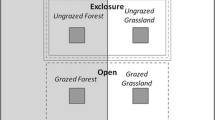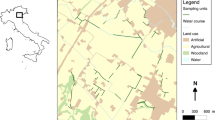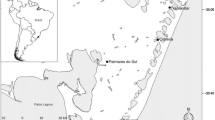Abstract
Despite increasing recognition of the role spatial pattern can play in ecosystem function, few studies have quantified spatial heterogeneity in savanna ecosystems. The spatial distribution of herbaceous biomass and species composition was measured across three scales in a semi-arid savanna in central Kenya, and patterns were related to environmental variables at different scales. Herbaceous biomass declined across a rainfall gradient and from upper to lower topographic positions, but variation within a site (across 5–50 m) was similar in magnitude to among-site variation associated with rainfall and topography. Geostatistical analyses showed that patchiness at scales of 5–25 m explained 20% of total variation in herbaceous biomass. This pattern arose from the presence of both 5–10-m diameter patches containing high herbaceous biomass (> 170 g m−2) and 5–10-m diameter patches characterized by nearly bare soil surfaces (< 40 g m−2). Patch structure was contingent on topography, with larger bare patches at ridgeline and upper hillslope positions. Grass species distributions showed the greatest degree of patch structure and species turnover across distances of 5–45 m. Additional community variation was associated with topography, with minimal variation in species composition across the rainfall gradient. Pattern diversity significantly exceeded levels reported for four other grassland ecosystems, suggesting fundamental differences in local processes generating spatial pattern. It is hypothesized that heterogeneously distributed grazing pressure, interacting with the distribution of shrub canopies, is an important factor generating such high levels of small-scale patch structure in this savanna.
Similar content being viewed by others
References
Adler P.B., Raff D.A. and Lauenroth W.K. 2001. The effect of grazing on the spatial heterogeneity of vegetation. Oecologia 128: 465–479.
Aguiar M.R. and Sala O.E. 1999. Patch structure, dynamics and implications for the functioning of arid ecosystems. Trends in Ecology and Evolution 14: 273–277.
Ahn P.M. and Geiger L.C. 1987. Kenya soil survey–soils of Laikipia District. Ministry of Agriculture, National Agricultural Laboratories, Kabete, Kenya.
Bakker J.P., de Leeuw J. and van Wieren S.E. 1983. Micro-patterns in grassland vegetation created and sustained by sheep-grazing.Vegetatio 55: 153–161.
Beals E.W. 1969. Vegetational change along altitudinal gradients.Science 165: 981–985.
Belsky A.J. 1992. Effects of grazing, competition, disturbance, and fire on species composition and diversity in grassland communities.Journal of Vegetation Science 3: 187–200.
Belsky A.J., Amundson R.G., Duxberry R.M., Riha S.J. and Mwonga S.M. 1989. The effects of trees on their physical, chemical and biological environment in a semi-arid savanna in Kenya. Journal of Applied Ecology 26: 1004–1024.
Collins S.L. 1992. Fire frequency and community heterogeneity in tallgrass prairie vegetation. Ecology 73: 2001–2006.
Collins S.L. and Glenn S.M. 1990. A hierarchical analysis of species abundance patterns in grassland vegetation. American Naturalist 135: 633–648.
Condit R., Pitman N., Leight E.G., Chave J., Terborgh J., Foster R.B. et al. 2002. Beta-diversity in tropical forests trees. Science 295: 666–669.
D'Herbes J.M., Valentin C., Tongway D.J. and Leprun J.C. 2001.Banded vegetation patterns and related structures. In: Tongway D.J., Valentin C. and Seghiere J. (eds), Banded Vegetation Patterning in Arid and Semiarid Environments. Springer-Verlag, New York, NY, USA, pp. 1–19.
Edwards G.R., Bourdot G.W. and Crawley M.J. 2000. Influence of herbivory, competition, and soil fertility on the abundance of Cirsium arvense in acid grassland. Journal of Applied Ecology 37: 321–334.
Fisk M.C., Schmidt S.K. and Seastedt T.R. 1998. Topographic patterns of above-and belowground production and nitrogen cycling in alpine tundra. Ecology 79: 2253–2266.
Frank D.A., Inouye R., Huntly N., Minshall G. and Anderson J. 1994. The biogeochemistry of a north-temperate grassland with native ungulates: nitrogen dynamics in Yellowstone National Park. Biogeochemistry 26: 163–188.
Frank D.A. and McNaughton S.J. 1990. Aboveground biomass estimation with the canopy intercept method: a plant growth form caveat. Oikos 57: 57–60.
Frank D.A. and McNaughton S.J. 1991. Stability increases with diversity in plant communities: empirical evidence from the 1988 Yellowstone drought. Oikos 62: 360–362.
Frank D.A., McNaughton S.J. and Tracy B.F. 1998. The ecology of the earth's grazing ecosystems. Bioscience 48: 513–521.
Frelich L., Calcote R., Davis M. and Pastor J. 1993. Patch formation and maintenance in an old-growth hemlock-hardwood forest.Ecology 74: 513–527.
Fuhlendorf S.D. and Smiens F.E. 1998. The influence of soil depth on plant species response to grazing within a semi-arid savanna.Plant Ecology 138: 89–96.
Gabriela P., Anchorena J. and Collantes M.B. 2000. Spatial micropatterns in the steppe of Tierra del Fuego induced by sheep grazing. Journal of Vegetation Science 11: 43–50.
Gamma Design Software 1998. GS+: Geostatistics for the Environmental Sciences, Version 3.07. Plainwell, Michigan, USA.
Georgiadis N.J. 1989. Microhabitat variation in an African savanna: effects of woody cover and herbivores in Kenya. Journal of Tropical Ecology 5: 93–108.
Gibson D.J. 1988. The relationship of sheep grazing and soil heterogeneity to plant spatial patterns in dune grassland. Journal of Ecology 76: 233–252.
Glenn S.M., Collins S.L. and Gibson D.J. 1992. Disturbances in tallgrass prairie: local versus regional effects on community heterogeneity. Landscape Ecology 7: 243–252.
Goovaerts P. 1998. Geostatistical tools for characterizing the spatial variability of microbiological and physico-chemical soil properties. Biology and Fertility of Soils 27: 315–334.
Gross K.L., Pregitzer K.S. and Burton A.J. 1995. Spatial variation in nitrogen availability in three successional plant communities.Journal of Ecology 83: 357–367.
Hiernaux P. 1998. Effects of grazing on plant species composition and spatial distribution in rangelands of the Sahel. Plant Ecology 138: 191–202.
Kelly R.D. and Walker B.H. 1976. The effects of different forms of land use on the ecology of a semi-arid region in south-eastern Rhodesia. Journal of Ecology 64: 553–576.
Klausmeier C.A. 1999. Regular and irregular patterns in semiarid vegetation. Science 284: 1826–1828.
Knapp A.K., Blair J.M., Briggs J.M., Collins S.L., Hartnett D.C., Johnson L.C. et al. 1999. The keystone role of bison in North American tallgrass prairie. Bioscience 49: 39–50.
Le Houerou H.N. 1989. The Grazing Land Ecosystems of the African Sahel. Springer-Verlag, New York, NY, USA.
Ludwig J.A. and Tongway D.J. 1995. Spatial organization of landscapes and its function in semi-arid woodlands, Australia.Landscape Ecology 10: 51–63.
McCune B. and Mefford M.J. 1999. Multivariate Analysis of Ecological Data Version 4.01. MjM Software, Gleneden Beach, Oregon, USA.
McNaughton S.J. 1968. Structure and function in California grasslands. Ecology 49: 962–972.
McNaughton S.J. 1983. Serengeti grassland ecology: the role of composite environmental factors and contingency in community organization. Ecological Monographs 53: 291–320.
McNaughton S.J. 1994. Conservation goals and the configuration of biodiversity. In: Forey P.L., Humphries C.J. and Vane-Wright R.I. (eds), Systematics and Conservation Evaluation. Clarendon Press, Oxford, UK, pp. 41–62.
Pacala S.W. and Levin S.A. 1997. Biologically generated spatial pattern and the coexistence of competing species. In: Tilman D. and Kareiva P. (eds), Spatial Ecology: the Role of Space in Population Dynamics and Interspecific Interactions. Princeton University Press, Princeton, NJ, USA, pp. 204–232.
Pastor J., Dewey B., Moen R., Mladenoff D.J., White M. and Cohen Y. 1998. Spatial patterns in the moose-forest-soil ecosystem on Isle Royale, Michigan, USA. Ecological Applications 8: 411–424.
Polhill R.M. (ed.) 1972–1982. Flora of Tropical East Africa, Gramineae., Rotterdam, Netherlands, Part 1 (1972) by W.D.Clayton, Whitefriars Press, London, UK; Part 2 (1974) byW.D.Clayton, S.M. Phillips, and S.A. Renvoize, Whitefriars Press, London, UK; Part 3 (1982) by W.D. Clayton and S.A. Renvoize, A.A. Balkema.
Reid K.D., Wilcox B.P., Breshears D.D. and MacDonald L. 1999. Runoff and erosion in a pinon-juniper woodland: influence of vegetation patches. Soil Science Society of America Journal 63: 1869–1879.
Rietkirk M., Ketner P., Burger J., Hoorens B. and Olff H. 2000.Multiscale soil and vegetation patchiness along a gradient of herbivore impact in a semi-arid grazing system in West Africa.Plant Ecology 148: 207–224.
Rietkerk M. and van de Koppel J. 1997. Alternate stable states and threshold effects in semi-arid grazing systems. Oikos 79: 69–76.
Rietkerk M., van den Bosch F. and van de Koppel J. 1997. Sitespecific properties and irreversable vegetation changes in semiarid grazing systems. Oikos 80: 241–252.
Robertson G.P. and Gross K.L. 1994. Assessing the heterogeneity of below-ground resources: quantifying pattern and scale. In: Caldwell M.M. and Pearcy R.W. (eds), Plant Exploitation of Environmental Heterogeneity. Academic Press, New York, NY, USA, pp. 237–253.
Rodriguez M.A. and Gomez-Sal A. 1994. Stability may decrease with diversity in grassland communities: empirical evidence from the 1986 Cantabrian Mountains (Spain) drought. Oikos 71: 177–180.
Sala O.E., Oesterheld M., Leon R.J.C. and Soriano A. 1986. Grazing effects upon plant community structure in subhumid grasslands of Argentina. Vegetatio 67: 27–32.
Sankaran M. 2001. Disturbance, diversity and community dynamics in an Indian savanna ecosystem. PhD Dissertation, Syracuse University, Syracuse, USA.
Schimel D.S., Stillwell M.A. and Woodmansee R.G. 1985. Biogeochemistry of C, N, and P on a catena of the shortgrass steppe. Ecology 66: 276–282.
Schlesinger W.H., Reynolds J.F., Cunningham G.L., Huenneke L.F., Jarrell R.M., Virginia W.M. et al. 1990. Biological feedbacks in global desertification. Science 247: 1043–1048.
Schlesinger W.H., Raikes J.A., Hartley A.E. and Cross A.F. 1996.On the spatial pattern of soil nutrients in desert ecosystems.Ecology 77: 364–374.
Tongway D.J., Valentin C. and Seghieri J. 2001. Banded Vegetation Patterning in Arid and Semiarid Environments: Ecological Processes and Consequences for Management. Springer-Verlag, New York, NY, USA.
van der Waal R., Egas M., van der Veen A. and Bakker J. 2000.Effects of resource competition and herbivory on plant performance along a natural productivity gradient. Journal of Ecology 88: 317–330.
Weber G.E., Jeltsch F., van Rooyen N. and Milton S.J. 1998. Simulated long-term vegetation response to grazing heterogeneity in semi-arid rangelands. Journal of Applied Ecology 35: 687–699.
Webster R. and McBratney A. 1989. On the Akaike information criterion for choosing models for variograms of soil properties.Journal of Soil Science 40: 493–496.
Wedin D.A. and Tilman D. 1990. Species effects on nitrogen cycling: a test with perennial grasses. Oecologia 84: 433–441.
Whittaker R.H. 1972. Evolution and measurement of species diversity.Taxon 21: 213–251.
Wishart D. 1969. An algorithm for hierarchical classifications. Biometrics 25: 165–170.
Young T.P., Partridge N. and Macrae A. 1995. Long-term glades in Acacia bushland and their edge effects in Laikipia, Kenya. Ecological Applications 5: 97–108.
Author information
Authors and Affiliations
Rights and permissions
About this article
Cite this article
Augustine, D.J. Spatial heterogeneity in the herbaceous layer of a semi-arid savanna ecosystem. Plant Ecology 167, 319–332 (2003). https://doi.org/10.1023/A:1023927512590
Issue Date:
DOI: https://doi.org/10.1023/A:1023927512590




